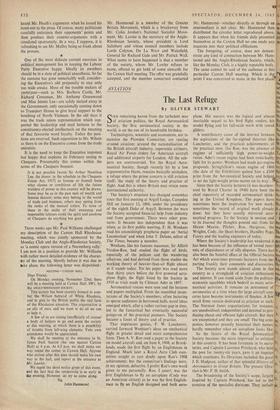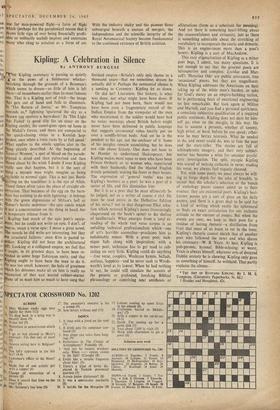AVIATION
The Last Refuge By OLIVER STEWART
SOLE remaining haven from the turbulent seas of aviation politics, the Royal Aeronautical Society, the first aeronautical society in the world, is on the eve of its hundredth birthday.
Technologists, scientists and economists, not to mention the Plowden Committee, are ranting around aviation; around the nationalisation of the British aircraft industry, supersonic airliners, Royal Air Force .Orders for American aircraft and additional airports for London. All the sub- jects are controversial. Yet the Royal Aero- nautical Society, though recently hit by a few argumentative blasts, remains basically unshaken, a refuge where the prime concern is still aviation itself; the study of the theory and practice of flight. And this is where Britain may retain some international authority.
The Society's structure has changed somewhat since that first meeting at Argyll Lodge, Campden Hill on January 12, 1866, under the presidency of the eighth Duke of Argyll. Between the wars the Society accepted financial help from industry and from government. There were other pres- sures. It became less independent than it was when, at its first public meeting, F. H. Wenham read his astonishingly prophetic paper on 'Aerial Locomotion' and when John T. Delane, editor of The Times, became a member.
Wenham, like his famous successor, Sir Alliott Verdon-Roe, had studied the flight of birds, especially of the pelican and the wandering albatross, and had derived from those studies the working theory of heavier-than-air flight almost as it stands today. Yet his paper was read more than thirty years before the first powered aero- plane flight, the flight listed by the Society in 1910 as trials made by Clement Ader in 1897.
Aeronautical visions were seen and the lectures and papers multiplied. From the mumbled incan- tations of the Society's members, often lecturing to sparse audiences in borrowed halls, novel ideas emerged which, after a rather curious gap in time, led to the fantastical but eventually successful goings-on of the ,practical pioneers. The Society became a fount of theory and of practice.
That impetuous genius, F. W. Lanchester, carried forward Wenham's ideas on mechanical flight in greater detail and more comprehensive form. Then A. V. Roe read a paper to the Society on model aircraft and, on June 8, 1908, at Brook- lands,, made the first flight by an Englishman in England. Much later a Royal Aero Club com- mittee sought to cast doubt upon Roe's 1908 achievement; but the committee's findings were, in my opinion, defective. I prefer Roe's own word given to me personally. Roe, I assert, was the first Englishman to fly an aeroplane (Cody was an American citizen) as he was the first English- man to fly an English designed and built aero- plane. His success was the logical and almost thi inevitable sequel to his bird flight studies, his th: model flying .and his full-scale work with towed ki gliders. the A contributory cause of the interval between 'th the aspirations of the far-sighted theorists like Ra Lanchester, and the practical achievements of WI the practical men, like Roe, was the absence of thi engines of sufficiently high power-to-weight `Li ratios. Ader's steam engine had been remarkably gr.( light for its power. Wenham had made gas engine 61( proposals. Stringfellow's steam engine of 1868 res (the date of the Exhibition) gained him a f100 thi prize from the Aeronautical Society and helpe av, to set the light-weight prime mover on its way.I1et Since then the Society lectures (it was incorpor- ated by Royal Charter in 1948) have been the chief repository of recorded aeronautical think- ing in the United Kingdom, The papers have sometimes been the inspiration for new work; sometimes the record of original work already done; but they have usually mirrored aero- nautical progress. To the Society in session and to its Journal the thoughts poured out; from Sir Hiram Maxim, Pilcher, Roe, Hargrave, the Wrights, Cody, the Short brothers, Handley Page, Fairey and the leading engineers of today.
Where the Society's leadership has weakened it has been because of the influence of vested inter- ests, of cliquishness or of silly disputes. There has also been the baneful effect of the Official Secrets Act which sometimes prevents lecturers from im- parting frankly their comments and discoveries.
The Society now stands almost alone in this country as a stronghold of aviation enthusiasm and interest. It can stand aside from the politico- economic squabbles which bedevil so many aero- nautical activities. It remains an instrument of aeronautics at a time when the large aircraft con- cerns have become instruments of finance. A few small firms remain dedicated to aviation as such. The Norman Jones organisations, for instance, are unsubsidised, independent and devoted to pro- ducing cheap and efficient light aircraft. But they are exceptional and they are small. The big com- panies, however proudly historical their names, hardly remember what an aeroplane looks like.
So the future of the Royal aeronautical Society becomes the more important to aviation in this country. It has been fortunate in its secre- taries, and Captain Laurence Pritchard, who held the post for twenty-six years, gave it an impetus which continues. Its librarians included the great J. E. Hodgson, author of that splendid History of Aeronautics in Great Britain. The present libra- rian is Mr. F. H. Smith. 1. The broadening of the Society's scope, largely inspired by Captain Pritchard,' has led to the 3• creation of the specialist divisions. They include '.
one for man-powered flight—a form of flight Which (perhaps for the paradoxical reason that it bows little sign of ever being financially profit- able or militarily useful) inspires and entertains many who cling to aviation as a form of art. With the industry shaky and the pioneer firms submerged beneath a morass of mergers, the independence and the scientific integrity of the Royal Aeronautical Society become fundamental to the continued existence of British aviation.































 Previous page
Previous page